Net-Zero Hero: Danny Martin
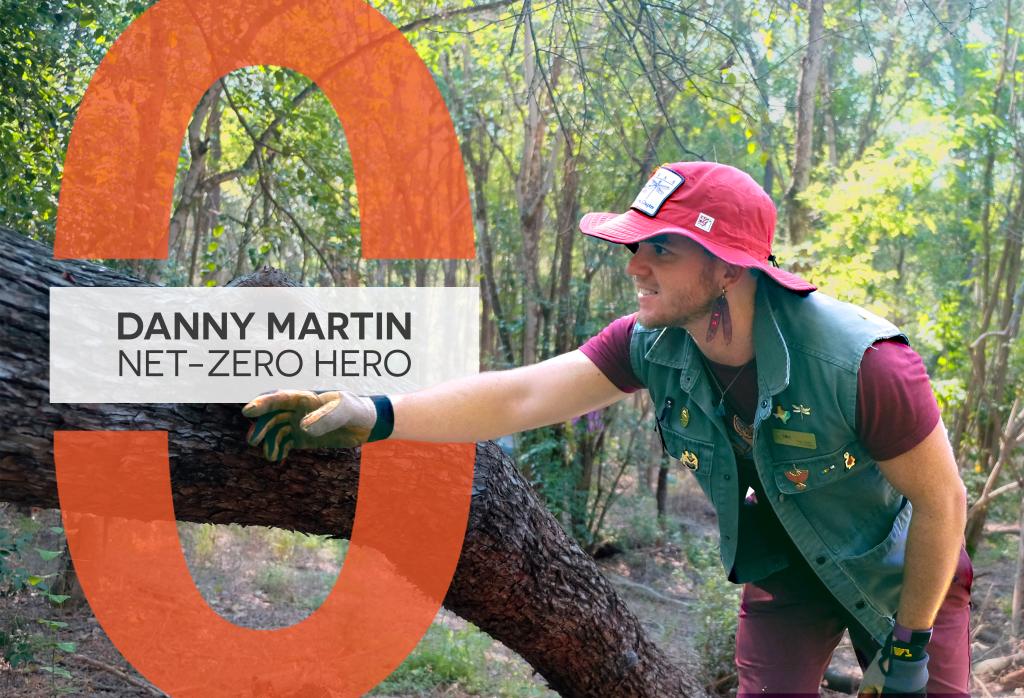
I’m helping to make Austin Net-Zero by becoming a naturalist and letting it inspire my actions, art, and community.
Meet our newest Net-Zero Hero: Danny Martin. Danny is an artist and Texas Master Naturalist who has always been inspired by the natural world. Through his art and volunteer actions, Danny seeks to pull together threads, build connections, and support a more just community.
We met with Danny at a preserve clean-up with the Capital Area Master Naturalists and again at his home to talk about his journey to this work, artistic vision, and advice for budding naturalists.
What inspired you to take action?
I’ve always been deeply curious. Growing up, this curiosity was focused on the manatees, mangroves, and freshwater springs of Florida. When I moved to Texas, I fell in love with our ecosystems, too. I’d get back from hours alone at the creek with a flood of questions, sketches, and a search for connections. Above all, I wanted to know what interactions would create positive ripples for the whole space. One day, a geologist friend of mine pointed out, “You know, that’s exactly the kinds of questions a naturalist would ask.” This really helped define what my brain — and my soul — wanted to do.
Naturalists seek to understand how all forms of life interact with each other and their environment. While this may include individual facts or observations, together, they weave a larger picture about the whole of nature. It’s the goal of a naturalist to make this picture ever clearer and apply this understanding to strengthen and repair our relationship with the environment.
It’s wild how easily we can feel separated from the earth as earthlings. If we live in that constant sense of separation, our actions fail to acknowledge or replicate the generous, circular, symbiotic character ingrained in life from the beginning of time. For many humans, reconnecting to the earth will mean asking questions, experiencing it with eyes open, and being willing to advance our perception of it.
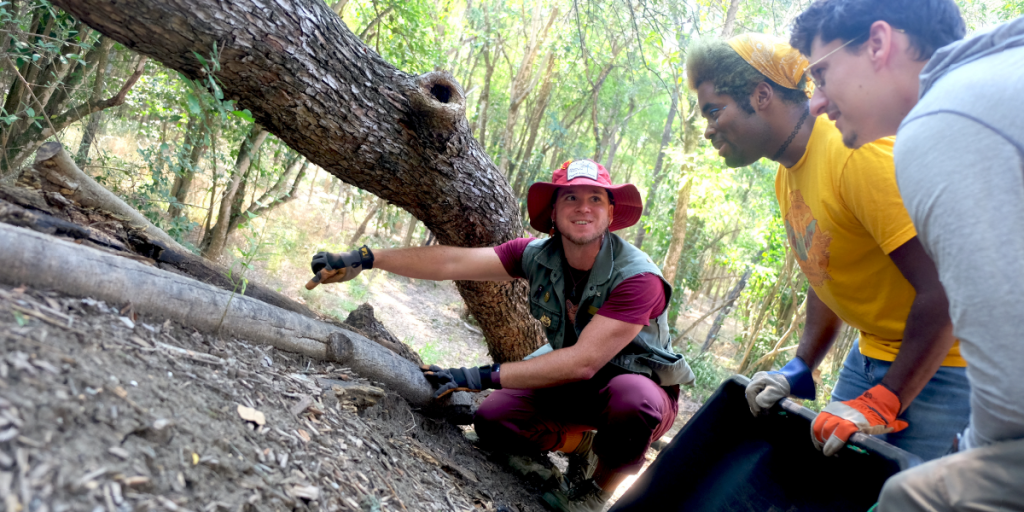

Above: Danny points out a burrowing spider during a preserve clean-up with the Capital Area Master Naturalists. Below: Creatures Danny has met across Austin.
And while it’s lovely to experience exotic landscapes, maybe the truest embrace of nature is acknowledging that it’s under your toes at all times. On your favorite trail, around your home, or in the middle of downtown — beautiful and essential natural processes are occurring. Things like oxygen production, energy flow, nutrient, and water cycles. Sometimes, we inhibit them unknowingly. Sometimes, we exploit them at the expense of other species. And, sometimes, we actually learn to foster a healthy interaction with them. But to make the level of changes that need to happen, we need to accept that nature is where we are. We need to imagine (or remember) what a positive relationship with the earth looks like and empower future generations to incorporate this understanding into every step we take.
How did you do it?
A big part of the journey has been my involvement with the Capital Area Master Naturalists (CAMN). I wanted to learn about essentially everything. Going back for a degree was not in the cards for me, and I was eager to put myself to use. When I heard about how CAMN works, it seemed like the perfect step forward. Becoming a Texas Master Naturalist involves a year of initial training with classes and field sessions covering geology, botany, mammalogy, herpetology, aquatic ecology, natural history, urban habitats, ecological restoration, and more. Even with training, I would hardly consider myself a master of anything, so I was also relieved to read in the curriculum, “None of us can truly master all of the disciplines pertaining to the natural world… becoming a true Master Naturalist is a goal that can be only approached, never attained.”


Above: Danny’s photos from a survey of the Purple Martin colony at Hornsby Bend and a CAMN trip to Bracken Cave in San Antonio, the largest known bat colony on Earth. Below: Danny joins the CAMN class of 2024 for a geology tour of McKinney Falls led by Nico Hauwert.
What makes this program really awesome is the drive to use your training to serve the community and local environment. Volunteer service is a part of the certification and is a requirement of recertification each year. Trained Master Naturalists partner with organizations across the state to lead and assist with research needs, restoration projects, and public education and outreach. It’s been a great launching point for joining all kinds of naturalist work. I’ve gotten to volunteer by planting native species at Viero Preserve, building greenhouses at Ecology Action, planting trees at Roy G. Guerrero Park, creating a pollinator garden at Brackenridge Field Lab, surveying species on the Colorado River, and more! Many of these projects were initiated by naturalists finding a gap or need in Austin’s current conservation efforts, like the seed collection at Maxwell Trail and new efforts to restore Red Bluff Preserve.

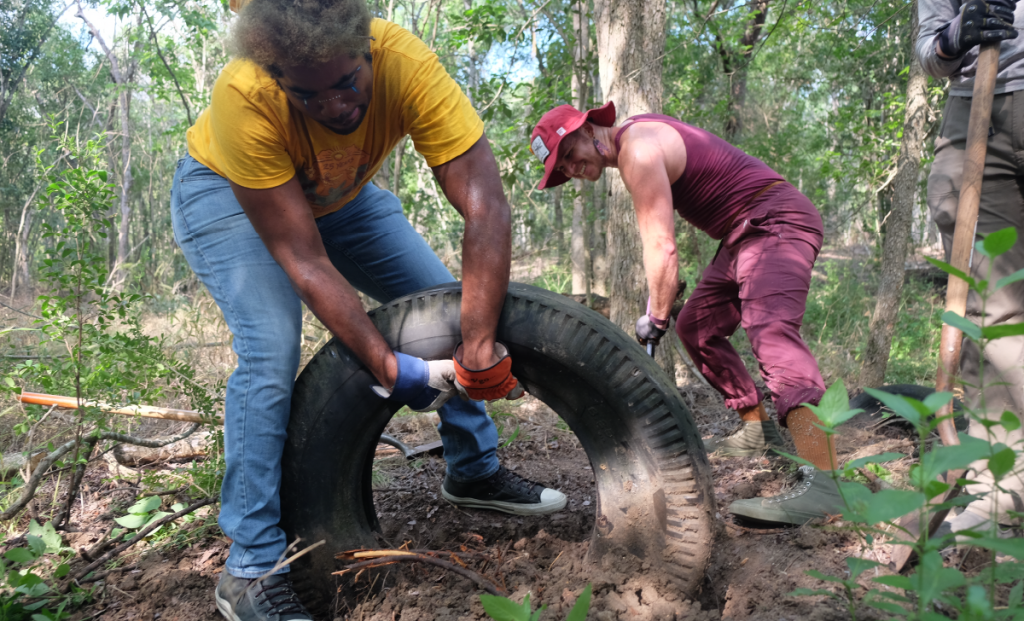
Above: CAMN initial training and volunteer projects at McKinney Falls State Park, Brackenridge Field Lab, Maxwell Trail, and Ecology Action (ordered left to right). Below: Danny works with his friend Craig to remove a buried tire from Red Bluff Preserve.
As we do this work, we get a sense of all the factors that contribute to the health of our local ecosystems. The curriculum acknowledges, “We are clearly facing challenges that require an understanding of complex ecological dynamics at a local level.” It can be overwhelming to see how messed up things are now, but at least knowing what you CAN do is the best way I’ve found to fight climate anxiety.
CAMN is always working on ways to make this training more available to anyone motivated to join. They recently started a second hybrid class to reach more folks. While rewarding, the initial training can be pretty time-intensive. Balancing life while finding an outlet for this waterfall of information is tough! That’s why I became a mentor for CAMN trainees. I’m normally pretty introverted, but some behavior switch happens in the naturalist space, and I can’t help but light up. If I can, I want to bring a little extra warmth, one-on-one support, and enthusiasm to help others navigate the journey.
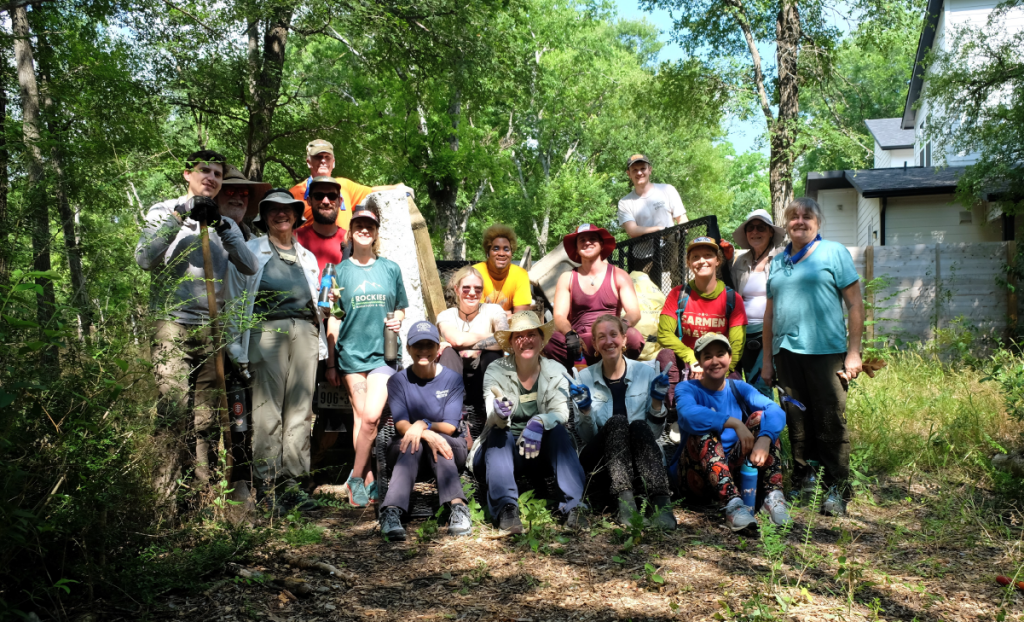
A group photo of CAMN members and community volunteers after a morning spent cleaning up Red Bluff Preserve.
What’s been most rewarding about getting involved in this way?
I love to see the individual spark that each person brings, even if it takes some gentle curiosity. The learning process doesn’t flow in one direction. Everyone brings their own experiences, and we all benefit from it. There are so many perspectives, sources of knowledge, and vibrant histories to draw an understanding of the natural world. MANY of these have been historically overlooked or not respected. That’s why it’s so important to welcome those conversations while we learn about our shared planet.
And I really, REALLY need to spotlight all of the hardest workers at CAMN. Training this many people is not easy and they all do it for free. I’m not always the most structured person, so we’re really blessed to have people willing to take true leadership roles and contribute their organizational skills. What I do is akin to frolicking in the meadows compared to the planning, communication, and problem-solving that gets done behind the scenes and in the weeds. To the leaders of CAMN (and other local non-profits): Y’all are INCREDIBLE. Please don’t ever doubt that you are inspiring people. You personally inspire me to grow, find more ways to be involved, and uplift the work being done.
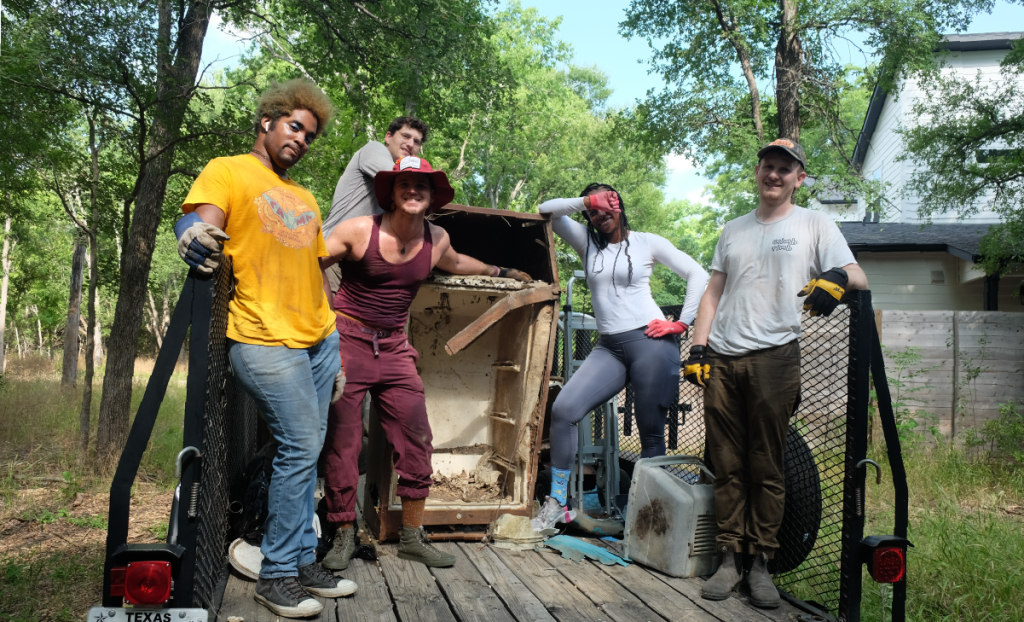

Above: Danny and other volunteers pose in the back of a trailer after successfully digging up and moving an old refrigerator from the Red Bluff Preserve during a recent workday. Below (left to right): CAMN’s President, Lisa Audiffred, rolls a tire out of Red Bluff Preserve; CAMN members Amy Simpson and Bryan Parsons dig out a garbage can abandoned in the preserve.
What’s been the toughest part?
One of the toughest parts is feeling like I’m not enough. There are naturalists who can identify hundreds of bird species by their call alone — I can barely remember my phone number sometimes. We learn from professionals with life-long careers in ecology. I have a demanding day job and currently do this and my art in the time I can spare. But I’m proud of what I can offer, and letting doubt creep in will only limit what I bring to the table. Besides, when you’re advocating and educating the public, it’s valuable to show that there are so many ways to integrate nature stewardship into your own way of life.
How do you connect to nature as an artist? Is there a nature-based art piece you’re really proud of?
I’ve kind of gone rogue as an artist. I don’t have a solid series of work in one medium or style. Whatever material best embodies the idea is where I stretch. This has jumped from drawing to painting, woodworking, clay, sewing, soldering, and other media. Most of what I make spills out as gifts to people who are on my mind, exploring personal inspiration, or filling needs I come across. It’s not the way to make money or prominence, but it’s valid! Since creating things is also how I try to honor something or understand it better, most of it is also related to nature.

Left to right: Leftover fruits and veggies being dehydrated to make into earrings; stained glass lighting inspired by rock formations; progress on a vase made with repurposed plastic and painted clay coral snakes.
Of course, nature is beautiful and has long been a source of inspiration. But how can we really show respect to the original subject? I think one way is to capture an authentic representation. This doesn’t mean it has to be ultra-realistic, but there should be details, an essence, informed by thoughtful observation. It’s easy to tell when an artist doesn’t really care about the subject; the unholy shapes they use for bats and snakes in mass-produced decorations always get to me a bit. Another thought is to use a process or materials that reflect the nature of your subject. If your subject is a highly sensitive species, use responsibly sourced and repurposed materials, or even dedicate part of the proceeds to their conservation. I made earrings from acorns and native seed pods, and since dispersal is the entire purpose of a seed, it seemed right to let them fall out when they wanted instead of trying to attach them permanently. The way these informed details and decisions can be layered is truly unlimited, and it’s why I’m always motivated to try new ideas.
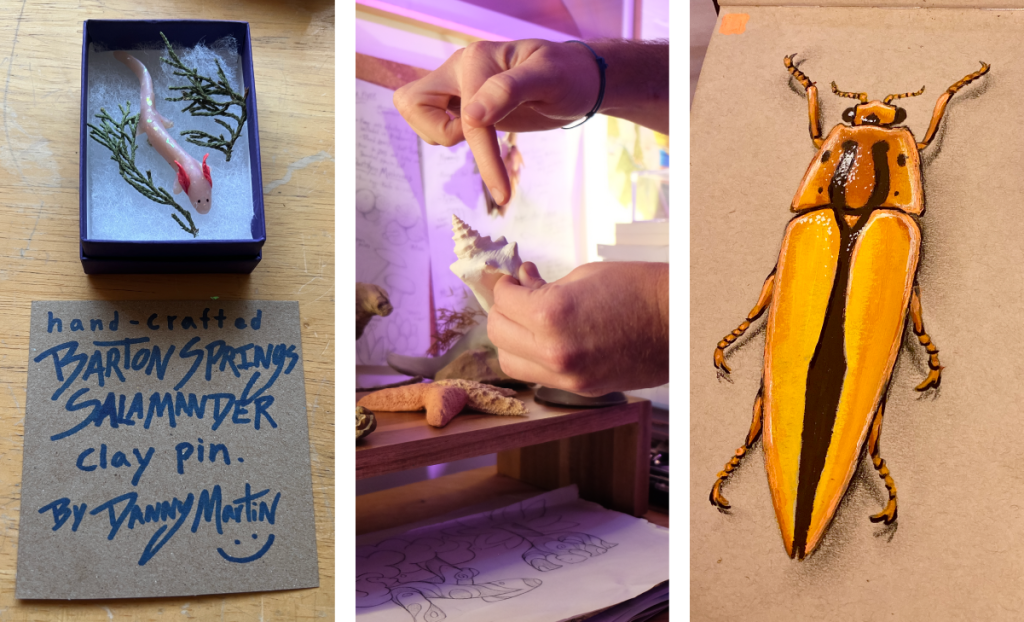

Above (left to right): A Barton Springs Salamander pin on by Danny on display; Danny points out the way to rebuild a found shell using clay as part of his CAMN project; a painting of a beetle. Below (left to right): A painting of his partner, part of a series that combines natural elements with portraits of loved ones; stickers of the logo designs he made for CAMN.
Art can also be a direct educational tool — especially through illustration and graphic design. Since graphic design is part of my day job, when I joined CAMN, I told myself, “You’re here to get outside and dig in the dirt — don’t work on their graphic design!” Inevitably, I was really motivated by the work I saw happening and couldn’t keep my hands off. Being in CAMN actually helped reignite my interest in graphic design altogether. My partner is diving into the Food System/Food Justice space, and when I saw the educational materials he brought home for the Austin/Travis County Food Plan, I loved how perfectly the layout and illustrations delivered the information. The concept of food planning was foreign to me, but in two minutes with the graphic, I had a basic framework, and the things my partner was gushing about all day started to make sense. It reminded me that good design and color can be so powerful when you’re trying to connect with as many humans as possible.
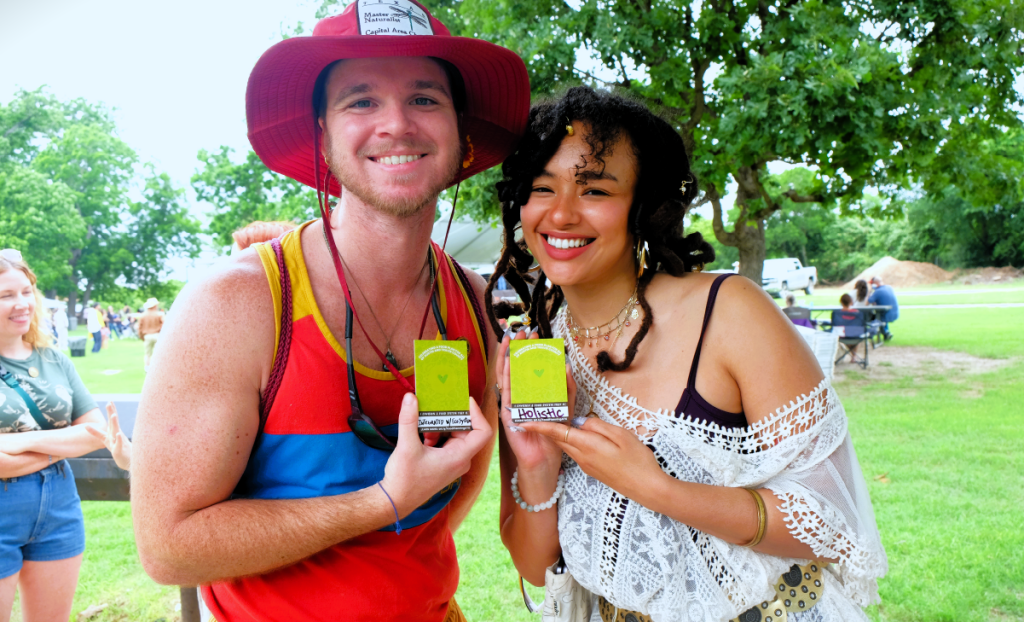
Danny poses with his partner Jeremy’s sister, Reneiss, at a food planning event.
My favorite recent project is also one of the most simple. I made about forty Firewheels, a Central Texas native wildflower, out of felt and thread. Then got to hand them out to the most recent CAMN trainees as a small graduation gift and ode to the wonder they felt in class. The final class was Botany, and they happened to be surrounded by fields of real Firewheels all day, then left with felt Firewheels pinned to their hats and clothes. It felt really special.
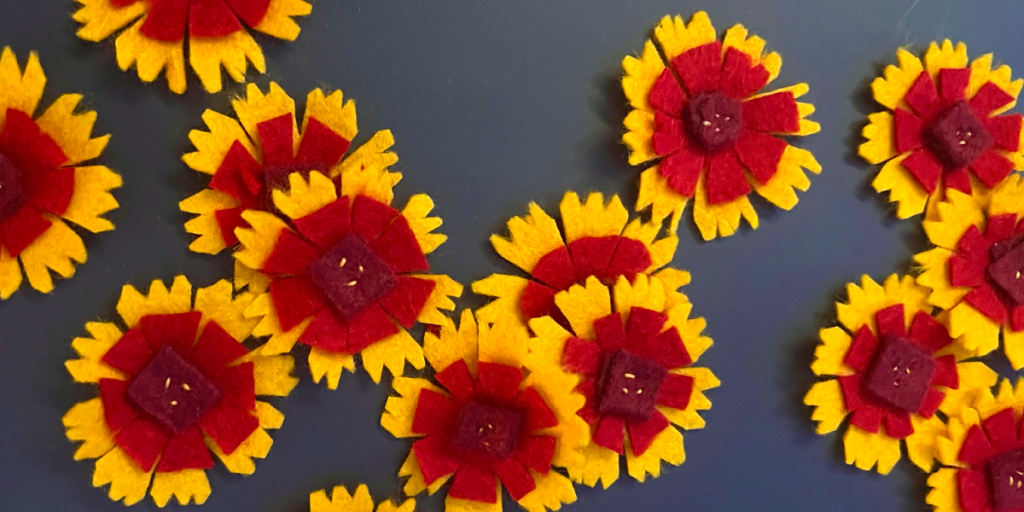

Above: Danny’s Firewheel pins in progress. Below: The CAMN class of 2024 cohort wears Danny’s pins during graduation.
With each piece I make, I want to deepen the intentionality that goes into it. While most of my art will continue to be intimate to me and my family, my hope is to one day dedicate myself more fully to promoting a deep and universal understanding of ecology through art. Let’s see where it goes!
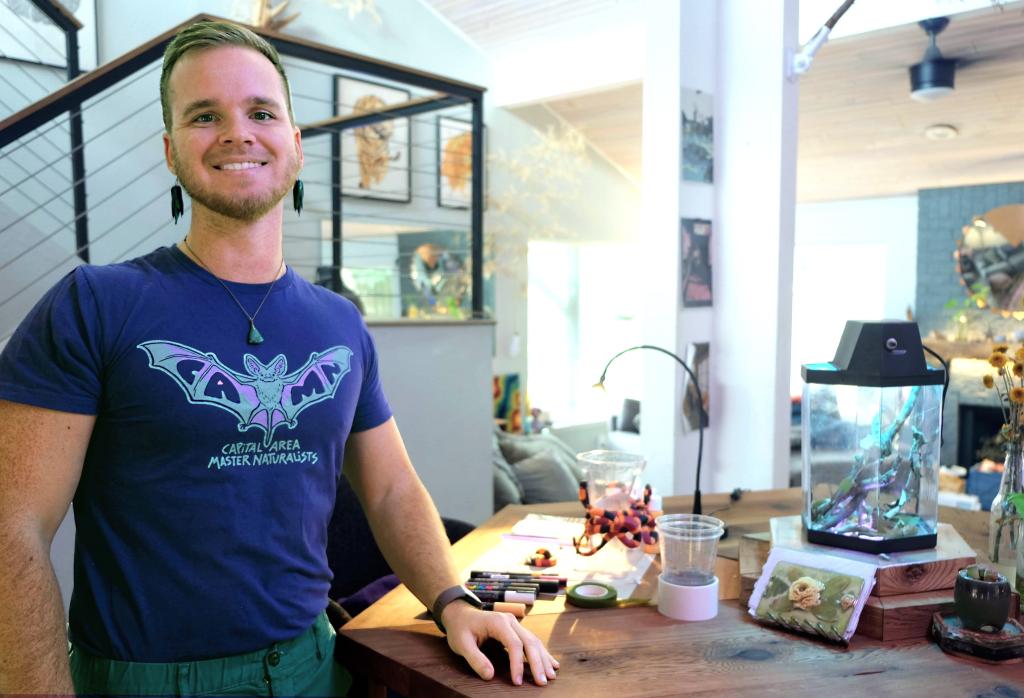
Danny stands at one of his woodworking projects: the Together Table. The table sits at the center of their home and is designed as a hexagon that can be reconfigured in many ways to support connection and community. The centerpiece is currently home to a Polyphemus Moth pupa that should emerge any moment.
Our interview will come out during Pride Month. Can you tell us a bit about how your own identity has influenced your connection with nature?
Mmm, this one goes deep. In the environment I was raised, a surface-level depiction of animal biology reinforced what was “natural.” Two of every animal on Noah’s Arc, Adam & Eve, Male/Female pairs — period. Any adaptation to that was wrong and unnatural. This made it tough as a budding queer person seeking connection. But even when I was little, this rigid summary seemed simplistic and nothing like the unbounded nature I knew.
It turns out nature can be incredibly queer! Hundreds of animal species have been documented in same-sex pairings, including dolphins, penguins, lions, geckos, etc. Clownfish change from male to female in response to social and environmental factors. Komoto dragons can reproduce asexually through parthenogenesis. Slugs are simultaneously male and female and engage in amazingly elaborate courtship rituals where they both become pregnant.

Danny with his chosen family.
Nothing is unnatural about this! It’s the variety of social structures within different communities that makes this whole planet even work! What IS observed in the ecosystem is a steadfast stride; a rhythm unbothered by the opinions and expectations of humans. Instead of confining nature to our terms, we can let it express to us the profound diversity that life is capable of.
Learning about all this has helped me feel even more at home in nature. I started to count myself among nature’s wonders. Ecological lessons — like balance, symbiosis, and restoration — became integrated into my relationships and sense of community. I’m thankful every day that I’ve been able to make my own chosen family with a deeper understanding of nature for reference.
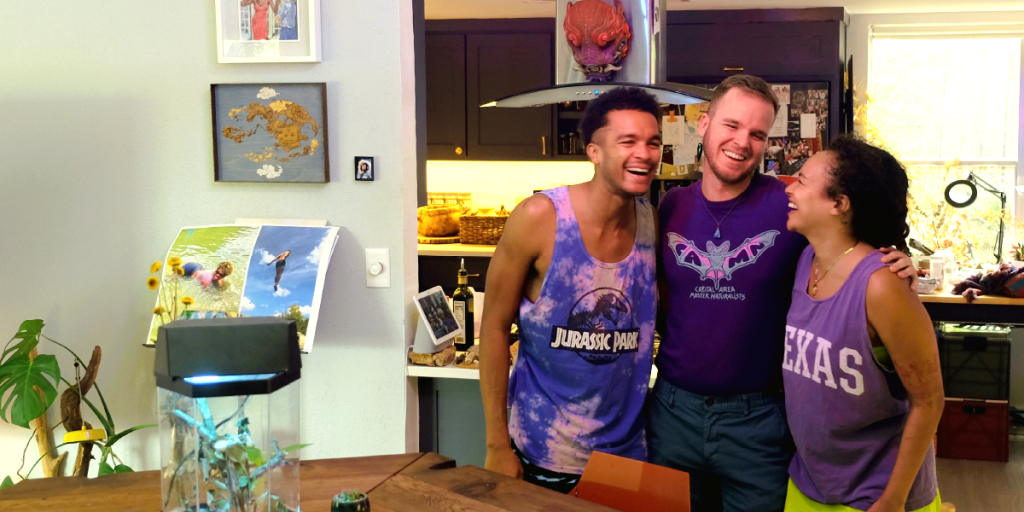

Above: Danny with some of his housemates and chosen family, Jeremy, his partner, and Reneiss, Jeremy’s sister. Below: Danny with friends exploring the outdoors.
Is there a book, documentary, or other piece of media you would recommend for folks wanting to learn more about these topics?
There are so many, but here are a few of my favorites:
- The Ologies podcast: curiosity given a voice, a wonderful, witty, relatably-anxious voice.
- Braiding Sweetgrass: life-changing and seemingly universally beloved by naturalists.
- Intersectional Environmentalist: an introduction to how the injustices faced by marginalized communities and the Earth are interconnected.
- POSE and Steven Universe: both show positive representation of queer and chosen family dynamics.
- Avatar: The Last Airbender: growing up with this animation inspired a lot of my early drawings, and you may be surprised by the lessons it can teach you.
What advice do you have for others?
This is the message I gave CAMN trainees at the beginning of the year: There is no one way to be a good naturalist. There are things only you can see! There are things only you can contribute! Chase your unique journey of interests and inspirations down rabbit holes, share them, layer them with what you learn from others, and then let them blossom in your life in whatever form they may take.
Also, humans, let’s keep the outdoors open! Many outdoor spaces have a way to go before they are equitable and accessible for all. This means examining socioeconomic factors that determine which part of the city gets funding for nature restoration. This also means opening our perspective of what it is to appreciate nature. One person might enjoy nature with quiet reverence, another by dancing in the wind. Let’s show respect to all forms and find ways to improve access while sustaining and enjoying our favorite habitats.

Discover how you can get involved in the Capital Area Master Naturalists. The next application deadline is June 30, 2024, for their new Hybrid learning program or October 31, 2024, for the in-person training. To learn about Austin’s net-zero goal and explore actions you can take to support a greener community, view the Austin Climate Equity Plan.
Share your Net-Zero contributions with us on X (formerly Twitter) or Facebook, and use #NetZeroHero. If you know a Net-Zero Hero (or heroes!) who should be recognized for their efforts, send your nomination to sustainability@austintexas.gov.
